Teach Your Dog to "Wait" for Permission Before Going Through Doors and Gates
By Michele Welton, Dog Trainer, Breed Selection Consultant, Author of 15 Dog Books
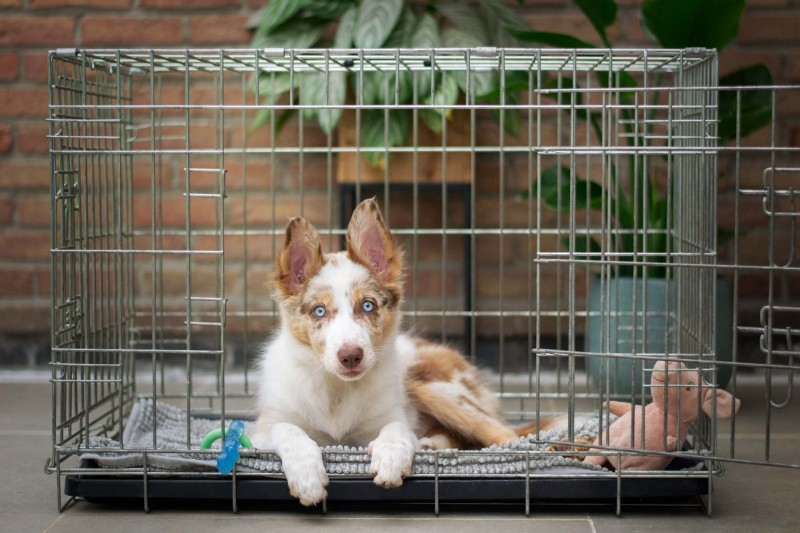
Good news! If you're following my training program, you may have already introduced this word when you were crate-training your pup. When you open his crate or pen, instead of letting him charge out, you always have him Wait for a few seconds before releasing him with "Okay."
Right?
If not, read that article and start doing it now. It's an important lesson in being calm, patient, and waiting for your permission.
Once a pup is older than 12 weeks and behaves nicely on a leash, I also show him how to Wait at doors and gates. He mustn't go through them without permission.
Why is this behavior so valuable? Well, let's see....
 "Watch out for the dog!" Kathy cried. Her friend Mary Sue had just arrived and started to pull open the screen door so she could come into the kitchen.
"Watch out for the dog!" Kathy cried. Her friend Mary Sue had just arrived and started to pull open the screen door so she could come into the kitchen.
Spotting the crack of daylight, Jake made a mad dash for it.
Mary Sue leaped backward and managed to slam the screen door a split second before Jake barreled into it, leaving yet another nose print impression in the battered mesh.
Mary Sue frowned through the screen at the exuberantly jumping dog. "What a nuisance!" she thought. "Why do they let him run through open doors?"
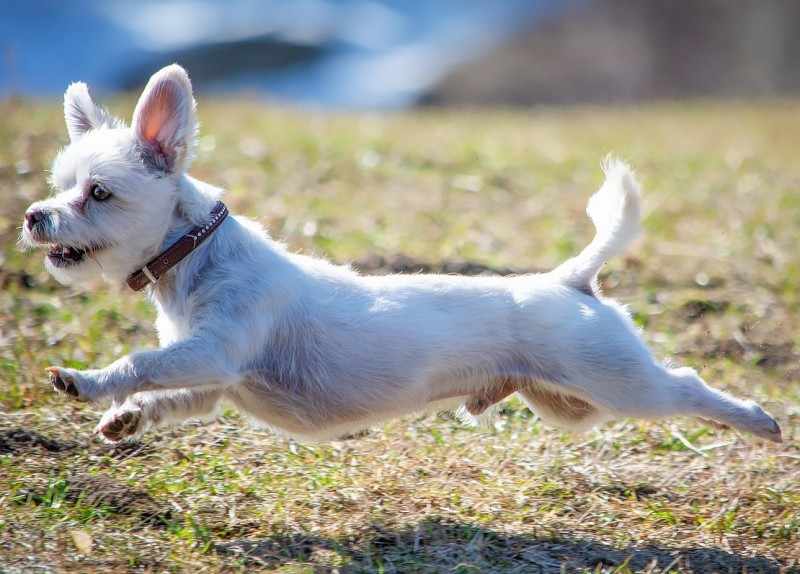
Why, indeed? Door-rushing behavior is unacceptable for several reasons:
- First, it could cost your pup his life. If he gets through the door and spies some temptation across the street – a cat or squirrel – he might end up hit by a car.
- Second, it's unfair to your guests. Visitors shouldn't need to be paranoid about your dog barreling past them. As our dogs' guardians, it's our responsibility to teach them to stay put, even when a door or gate tempts them.
- Third, it's a calmness issue. Your pup needs to learn to control his impulses even when distractions tempt him.
- Finally, it's a leadership issue. Wait requires your dog to acknowledge your existence, to look to you for direction, to wait for your permission before doing something he wants to do.
Some trainers teach this behavior without using the word "Wait." In other words, they teach the pup to wait automatically at every door and gate, to never go through unless they hear "Okay."
You can choose to teach it either way: with or without a command. I start with the word and phase it out later when it's obvious the pup no longer needs it.
How to teach "Wait" at the door
1) You're indoors, with your pup on leash. Walk toward the front door. (If there's also a screen door on the outside, prop the screen open ahead of time so it won't be blocking you when you open the front door.)
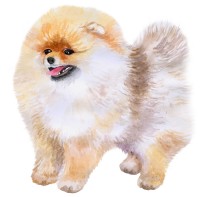 2) Put your hand on the doorknob and say, "Wait." Pronounce the word crisply. Pronounce that "t" at the end – waiT. And state it confidently. Don't ask "Wait?" as though you're timidly asking him to do you a favor.
2) Put your hand on the doorknob and say, "Wait." Pronounce the word crisply. Pronounce that "t" at the end – waiT. And state it confidently. Don't ask "Wait?" as though you're timidly asking him to do you a favor.
3) Open the door. If your puppy tries to rush out, bring him back inside by using the Loosen-Tug technique you learned when teaching him to walk nicely on a leash.
Be quick! Don't let him get all the way through the door before you pull him back. As soon as one front foot goes over the threshold, pull him back, and as soon as his foot comes back inside, loosen the leash so that the clip is hanging straight down.
Now it's all about repetition. Keep giving him the opportunity to move over the threshold by loosening the leash. If he makes that choice, repeat your leash technique.
You can also use spatial pressure to discourage him from crossing the threshold. That means crowding him with your body, even bumping him slightly with your leg to make him move back and away from the threshold. Trainers call this "claiming space."
When their leader suddenly moves toward them, claiming the space, many respectful pups will instinctively move back.
When he stops trying to cross the threshold and stands there on a loose leash....
Say, "Yes. Good boy." Give him a treat. Close the door. Repeat. When you can open the door without him trying to go through at all, say, "Okay" and go out for your walk.
From now on, whenever you take your pup for a walk, have him "Wait" inside the open door for 5 seconds or so, until you say, "Okay."
"Wait" with distractions
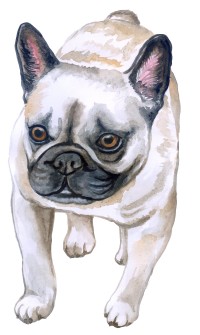 Once a pup is Waiting nicely and is more than 6 months old, I like to add distractions. Assume the front door is open and your pup is standing there with you on a loose leash.
Once a pup is Waiting nicely and is more than 6 months old, I like to add distractions. Assume the front door is open and your pup is standing there with you on a loose leash.
Hum or whistle a tune. Do a few knee bends or jumping jacks. Sit in a chair near the door (inside the house) and read aloud from a book. Talk to an imaginary visitor at the door.
What should your dog be doing during this time? Well, he can stand near the open door. Or he can sit or lie down. Or he can walk around within the limits of the leash. His choice. He just can't put his foot over the threshold. No barking or pulling on the leash, either!
Is he still waiting? Great! Don't forget to praise... but calmly. Don't get him all excited.
Wait on a long leash
After days of practice, swap his six-foot leash for a long (15- to 20-foot) leash or cord. Now with your front door wide open, you can wander around the room holding the cord. Your pup can follow you around if he wants. Or he can hang out near the open door, standing or sitting or lying down, looking outside and sniffing. His choice. He just can't cross the threshold, pull on the leash, or bark.
Wait while YOU go outside
After more days of practice, go back to his regular leash. With the front door open and both of you standing inside the house, repeat "Wait" and then YOU step over the threshold.
You want him to stay on his side, so help him at first by keeping gentle tension on the leash – upward and backward – as you step through, to help hold your pup on HIS side of the door. This is new to him and you want him to succeed!
As soon as your foot hits the ground outside, turn and face him. Now he should be inside the house and you should be just outside, on the porch or stoop, holding tension on the leash to keep him indoors.
 Caution him again to "Wait" and loosen the leash. I hold up my hand like a stop sign. If he tries to join you outside, the moment his foot crosses the threshold, use the leash to guide/slide him back inside the house.
Caution him again to "Wait" and loosen the leash. I hold up my hand like a stop sign. If he tries to join you outside, the moment his foot crosses the threshold, use the leash to guide/slide him back inside the house.
Important: try to do that without moving your feet. You don't want to go back in the house with him. Once he's back inside, caution him again to "Wait" and loosen the leash, giving him another chance to either rush out or stay put.
No matter how many times you have to guide him back inside, when he does finally stand there – actually, he can stand or sit or lie down or even walk back and forth, just so long as he stays on his side of the threshold – he has just done a marvelous Wait. Praise him calmly (but don't let him cross the threshold yet).
Finally, say, "Okay" and let him come across.
But not always! Instead of always letting him come outside to join you, sometimes you should go back inside the house and close the door.
In other words, don't always give him an "Okay" to come out. In practical life, you will sometimes need to go outside for a moment by yourself – say, to accept or sign for a package. Then you'll go back inside without your pup ever being allowed out. So he should learn early on that he doesn't always get to cross the boundary after "Wait."
Teaching your dog to look to you for direction and guidance is immensely reassuring to him!
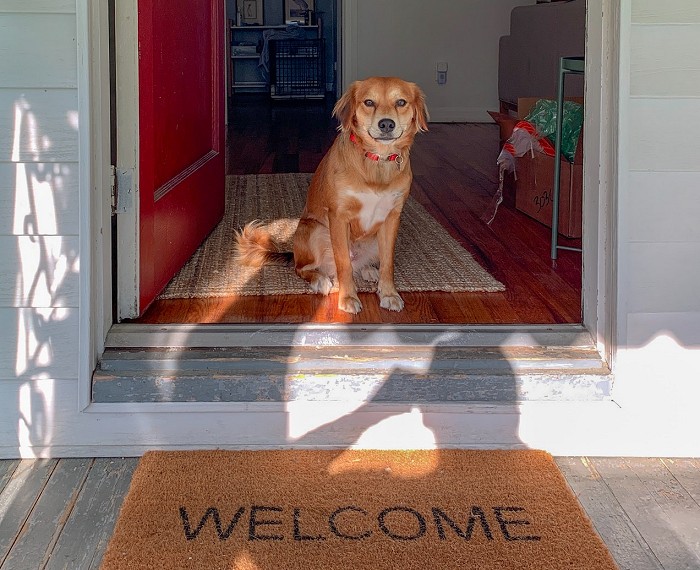
Other places to practice "Wait"
- Have your pup "Wait" before going INTO your house. For example, when you return to your house after a walk, say "Wait" and open the front door but don't let him go IN until you've given the "Okay."
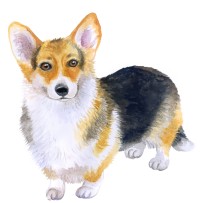 Have him "Wait" at the back door before you let him out into the yard.
Have him "Wait" at the back door before you let him out into the yard.- Have him "Wait" before going through the sliding doors to the patio.
- Have him "Wait" before going in – or out – of the gate to your property.
Don't ask your dog to "Wait" OFF LEASH anywhere where he could dash into the street. A dog will always choose the worst possible moment to forget his training – and all it takes is once for your poor pup to be dead.
My best-selling books – now available FREE on my website
 Respect Training For Puppies: 30 seconds to a calm, polite, well-behaved puppy is for puppies 2 to 18 months old. Your puppy will learn the 21 skills that all family dogs need to know. Click here to read for free.
Respect Training For Puppies: 30 seconds to a calm, polite, well-behaved puppy is for puppies 2 to 18 months old. Your puppy will learn the 21 skills that all family dogs need to know. Click here to read for free. Teach Your Dog 100 English Words is a unique Vocabulary and Respect Training Program that will teach your adult dog to listen to you and do what you say. Click here to read for free.
Teach Your Dog 100 English Words is a unique Vocabulary and Respect Training Program that will teach your adult dog to listen to you and do what you say. Click here to read for free. 11 Things You Must Do Right To Keep Your Dog Healthy and Happy helps your dog live a longer, healthier life. Get my honest advice about all 11 Things before you bring home your new puppy, because some mistakes with early health care cannot be undone. Click here to read for free.
11 Things You Must Do Right To Keep Your Dog Healthy and Happy helps your dog live a longer, healthier life. Get my honest advice about all 11 Things before you bring home your new puppy, because some mistakes with early health care cannot be undone. Click here to read for free.
